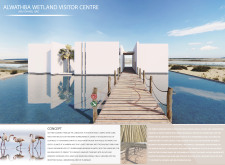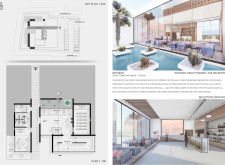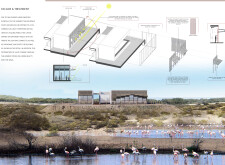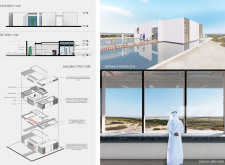5 key facts about this project
The Al Wathba Wetland Visitor Centre is located in Abu Dhabi, designed to serve as an educational and recreational hub for visitors. The building's form consists of a white cubic mass that reflects the nearby water, creating a feeling of lightness. This design approach promotes a strong connection to the surrounding environment, encouraging visitors to explore and engage with the wetland ecosystem.
Materials and Sustainability
The selection of materials in the design underscores an ecological approach. Warm white plaster highlights the desert’s natural colors, while reused tree trunks from the site are incorporated into pathways, emphasizing sustainability. This thoughtful use of local resources helps to reinforce the building's relationship with its landscape.
Interior Design and Spatial Experience
Inside the centre, there is a clear connection between indoor and outdoor areas. Natural light filters through, creating a warm and inviting atmosphere. The combination of flowing water and panoramic views enriches the visitor experience, allowing people to feel both modern comforts and the beauty of nature.
Sunlight Management and Performance
A key feature is the folding panel system, which effectively manages sunlight. These panels can be opened and adjusted to control the amount of light entering the space, providing shade as needed. Double-glazed glass enhances the energy efficiency of the building, contributing to a comfortable environment for visitors.
Structural Composition
The building's structural design includes a concrete slab with vapor control layers, insulation, and waterproofing. Strip foundations support the linear walls, while load-bearing wall systems are carefully designed to fit specific module sizes. This attention to structural detail ensures stability and longevity, addressing the challenges of the desert climate.
The folding panels create unique patterns of light and shadow throughout the day, enhancing the connection between the interior spaces and the natural landscape outside. This design detail invites continual exploration, making the visitor experience both engaging and informative.






















































